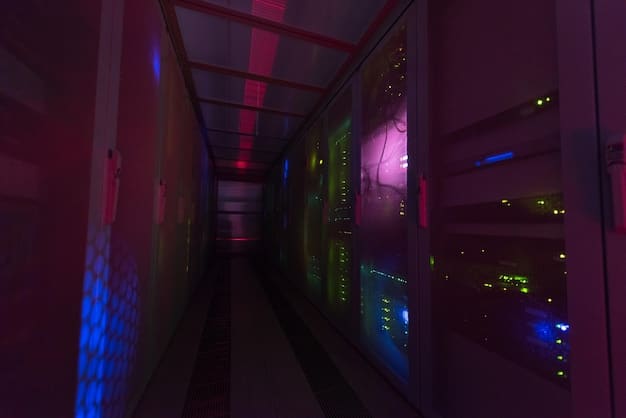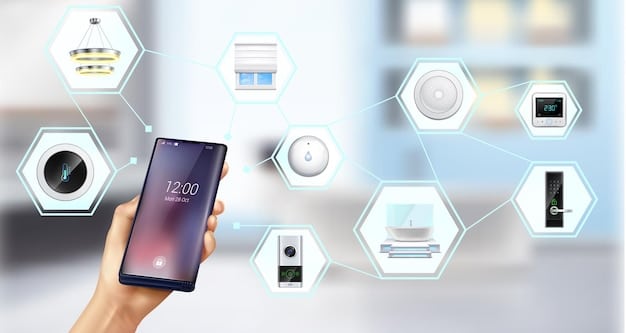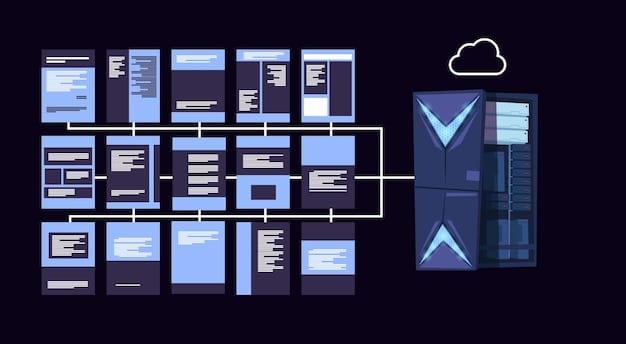What are the Latest Trends in Edge Computing for US Businesses?

What are the Latest Trends in Edge Computing and Their Implications for US Businesses? Edge computing is rapidly evolving, with trends like AI integration, enhanced security, and serverless architectures offering US businesses improved efficiency and new opportunities to innovate.
The rise of edge computing has transformed how businesses operate, especially in the US. But what are the latest trends in edge computing and their implications for US businesses? As technology evolves at an unprecedented pace, keeping up with these trends is crucial for maintaining a competitive edge.
This article will delve into the most recent advancements and explore how they are reshaping industries across the United States.
What are the Latest Trends in Edge Computing and Their Implications for US Businesses?
The integration of edge computing is no longer a futuristic concept; it’s a present-day reality. Understanding what are the latest trends in edge computing and their implications for US businesses is crucial for businesses looking to innovate and stay ahead of the curve.
AI and Machine Learning at the Edge
One of the most significant trends is the convergence of edge computing with Artificial Intelligence (AI) and Machine Learning (ML). This combination allows for real-time data processing and analysis, enabling faster decision-making.
By processing data closer to the source, businesses can reduce latency and improve the performance of AI applications, particularly in areas like predictive maintenance and autonomous vehicles.
- Enhanced Real-Time Analytics: AI-driven edge computing provides immediate insights, improving operational efficiency.
- Reduced Latency: Processing data at the edge minimizes delays, crucial for time-sensitive applications.
- Improved Decision-Making: Faster access to insights enables quicker and more informed decisions.
This trend has far-reaching implications for industries such as manufacturing, healthcare, and transportation, where real-time data processing is essential. The ability to analyze data on-site also enhances security and privacy by reducing the need to transmit sensitive information to centralized servers.

Enhanced Security Measures at the Edge
With the increasing volume of data processed at the edge, security has become a paramount concern. The latest trends emphasize robust security measures to protect sensitive data and infrastructure.
Implementing advanced encryption, intrusion detection systems, and secure boot processes helps mitigate the risks associated with distributed computing environments.
Zero Trust Architecture
The Zero Trust Architecture (ZTA) is gaining traction, requiring strict identity verification for every device and user, regardless of their location. This approach minimizes the attack surface and ensures that only authorized entities can access resources.
By adopting ZTA, US businesses can significantly enhance their security posture and protect against evolving cyber threats in edge computing environments.
- Strict Identity Verification: Ensuring only authorized users and devices access the network.
- Micro-Segmentation: Dividing the network into smaller, isolated segments to limit breach impact.
- Continuous Monitoring: Real-time threat detection and response to maintain a secure environment.
Investing in robust security solutions and adhering to best practices are essential for US businesses leveraging edge computing. This proactive approach not only safeguards data but also builds trust with customers and partners.
Serverless Edge Computing Architectures
Serverless architectures are transforming edge computing by allowing developers to deploy and run applications without managing servers. This approach simplifies development, reduces operational overhead, and improves scalability.
Serverless edge computing enables businesses to focus on innovation rather than infrastructure management, accelerating the deployment of new services and applications.
Benefits of Serverless Edge Computing
The advantages of serverless edge computing are numerous, from cost savings to improved resource utilization. By abstracting away the underlying infrastructure, developers can build and deploy applications faster and more efficiently.
This allows US businesses to respond quickly to changing market demands and capitalize on new opportunities. Serverless architectures also provide inherent scalability, ensuring that applications can handle varying workloads without performance bottlenecks.

- Simplified Development: Focus on code without managing servers.
- Reduced Operational Costs: Pay only for the resources consumed.
- Improved Scalability: Automatic scaling to handle fluctuating workloads.
US businesses are increasingly adopting serverless edge computing to drive innovation and improve operational efficiency. This trend is expected to continue as more organizations recognize the benefits of this flexible and cost-effective approach.
The Role of 5G in Edge Computing’s Evolution
The rollout of 5G networks is a game-changer for edge computing. With its ultra-low latency and high bandwidth, 5G enhances the capabilities of edge computing infrastructure, enabling new use cases and applications.
5G facilitates faster data transfer and processing, supporting real-time analytics and advanced applications like augmented reality and autonomous systems. 5G significantly improves the performance and reliability of edge computing deployments.
5G and IoT Synergies
The combination of 5G and the Internet of Things (IoT) is particularly powerful. With 5G connectivity, IoT devices can transmit vast amounts of data to edge servers for processing, enabling real-time monitoring and control. This synergy is transforming industries such as agriculture, manufacturing, and smart cities.
By leveraging 5G and IoT together, US businesses can unlock new levels of automation, efficiency, and innovation. The ability to connect and manage a large number of devices with minimal latency opens up a wide range of possibilities.
- Low Latency: Enables real-time data processing and analytics.
- High Bandwidth: Supports the transfer of large data volumes.
- Enhanced Reliability: Ensures consistent connectivity for critical applications.
As 5G networks continue to expand across the US, their impact on edge computing will only grow. Businesses that invest in 5G-ready edge solutions can gain a significant competitive advantage.
Implications for US Businesses: What are the Latest Trends in Edge Computing and Their Implications for US Businesses?
For US businesses, understanding what are the latest trends in edge computing and their implications for US businesses is crucial for staying competitive. The adoption of these technologies can drive significant improvements in efficiency, security, and innovation.
Edge computing enables businesses to process data closer to the source, reducing latency and improving the performance of real-time applications. This capability is particularly valuable in industries such as manufacturing, healthcare, and transportation.
Transforming Industries
The implications of edge computing extend across various sectors, each benefiting in unique ways. For example, in manufacturing, edge computing enables predictive maintenance by analyzing sensor data on-site.
In healthcare, it facilitates real-time monitoring of patients’ vital signs, improving patient outcomes. And in transportation, it supports autonomous vehicles by providing low-latency data processing for navigation and safety.
- Manufacturing: Predictive maintenance and improved operational efficiency.
- Healthcare: Real-time patient monitoring and enhanced diagnostics.
- Transportation: Support for autonomous vehicles and smart logistics.
By embracing these edge computing trends, US businesses can unlock new opportunities for growth and innovation and improve their bottom line. Staying informed and investing in the right technologies is essential for success in today’s rapidly evolving landscape.
| Key Aspect | Brief Description |
|---|---|
| 🚀 AI at the Edge | Enables real-time analytics and faster decision-making at the edge. |
| 🛡️ Enhanced Security | Robust security measures protect sensitive data and infrastructure. |
| 🌐 5G Integration | 5G’s low latency enhances edge computing performance. |
| ☁️ Serverless Edge | Simplifies development and reduces operational overhead. |
Frequently Asked Questions
AI at the edge enables real-time data analysis, providing immediate insights that improve operational efficiency and decision-making. It reduces latency and enhances security by processing data locally.
Key security considerations include implementing advanced encryption, intrusion detection systems, and adopting a zero-trust architecture. Continuous monitoring and strict identity verification are also crucial.
Serverless architectures simplify development, reduce operational costs, and improve scalability. They allow developers to focus on code without managing servers, enabling faster deployment of new applications and services.
5G technology enhances edge computing with ultra-low latency and high bandwidth, facilitating faster data transfer and processing. It supports real-time analytics and advanced applications like augmented reality and autonomous systems.
The latest trends include AI integration, enhanced security measures, and serverless architectures. For US businesses, these trends mean improved efficiency, new innovation opportunities, and a competitive advantage.
Conclusion
In conclusion, the trends in edge computing are rapidly evolving, presenting significant opportunities for US businesses. Embracing AI at the edge, enhancing security measures, adopting serverless architectures, and leveraging 5G technology can drive innovation, efficiency, and competitive advantage.
Staying informed about what are the latest trends in edge computing and their implications for US businesses is crucial for success in today’s fast-paced digital landscape. By investing in the right technologies and strategies, US businesses can unlock new levels of performance and growth.





